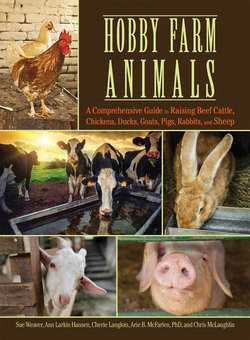Читать книгу Hobby Farm Animals - Chris McLaughlin - Страница 5
На сайте Литреса книга снята с продажи.
Hooves and Hide
ОглавлениеGood feet and legs are important in all cattle. Cows have cloven (two-part) hooves that average around 3½ × 4 inches. If a cow weighs 1,000 pounds, that’s a lot of weight coming down on those little hooves every time she takes a step, and she takes a lot of steps in a day to get food and water. Cattle don’t like mud or slippery surfaces because they can fall and hurt themselves; they will walk around bad footing if they can. Cattle hooves grow continuously, and long hooves cause lame cattle. If the herd is getting enough exercise, however, their hooves should not get too long. A few rocks in the pasture will help keep hooves worn down.
Cows also use their hooves to scratch themselves and to kick. They can kick both sideways and backward, and they’re quick as lightning. If they have horns, they’ll also use these to defend themselves, and a horn can do even more damage than a hoof. For this reason, many cattle owners prefer polled, or naturally hornless, cattle. You can also dehorn calves when they are quite young so that their horns never grow.
For pests that are too small to kick, such as biting flies, cattle have long tails for flicking them off, and their thick hides protect them from some insect species. But several kinds of flies can bite through cowhide, and some will even bore holes in hide and lay eggs there. The irritation and discomfort caused by flies can slow weight gain in calves and keep cows miserable on hot days. To stay warm in cold climates, cattle will grow longer winter coats. Unlike most dairy cows, beef cows will have hairy udders.
